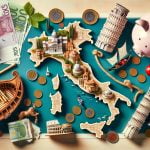Is it expensive to travel to Italy? This is a common question among travelers who dream of visiting this beautiful and historic country. In this article, we will explore the cost of traveling to Italy, including accommodation, dining, transportation, sightseeing, and shopping expenses. By the end of this article, you will have a better understanding of how much it costs to travel to Italy and valuable tips for making your trip more affordable.
Italy is a popular destination for tourists from around the world, known for its rich culture, stunning architecture, and delicious cuisine. However, some may be deterred by the perceived high cost of traveling to Italy. While it’s true that Italy can be an expensive destination, with careful planning and budgeting, it is possible to experience all that this beautiful country has to offer without breaking the bank.
In the following sections, we will delve into specific aspects of traveling in Italy and provide insights into the various costs that travelers may encounter. From finding budget-friendly accommodation and dining options to navigating transportation and managing sightseeing expenses, we aim to help you make informed decisions about your travel budget for Italy.
The Cost of Accommodation in Italy
When considering the overall expense of traveling to Italy, accommodation is often one of the most significant costs to factor in. However, there is a wide range of options available for travelers with varying budgets. For budget-conscious travelers, hostels and guesthouses are popular choices, offering affordable rates for shared or private rooms. These establishments often provide a comfortable and convenient place to stay while allowing visitors to save money on their accommodations.
On the other hand, those seeking a more luxurious experience can opt for upscale hotels and resorts that offer top-notch amenities and services. While these options may come with a higher price tag, they provide a level of comfort and sophistication that some travelers prioritize during their visit to Italy. Additionally, there are also boutique hotels and bed-and-breakfasts scattered throughout the country that offer a unique blend of charm and comfort at relatively reasonable prices.
When planning a trip to Italy, it is essential to consider the location and type of accommodation that best fits your budget and travel preferences. Researching different options in advance can help travelers find the best deals and offers available, ultimately helping them make informed decisions about where to stay during their visit.
By carefully considering all factors before making a reservation, travelers can find an option that not only fits their budget but also enhances their overall experience in Italy.
Dining and Food Expenses in Italy
When traveling to Italy, one of the most important aspects to consider is the cost of dining and food expenses. Italian cuisine is known for its incredible flavors and wide variety of dishes, but many travelers wonder if it is expensive to indulge in the culinary delights that the country has to offer.
Dining Out in Italy
Dining out in Italy can vary widely in cost depending on where you choose to eat. Fine dining restaurants and touristy areas tend to be more expensive, while local trattorias and small family-run osterias offer more affordable options. It’s also important to keep in mind that lunch is traditionally the main meal of the day in Italy, so opting for a light dinner or aperitivo can help save on food expenses.
Cost of Italian Delicacies
Italy is famous for its pizza, pasta, gelato, and other delicious delicacies. While these items are readily available throughout the country, prices can fluctuate depending on the region and whether you’re dining in a tourist hotspot. However, street food such as arancini (rice balls) and paninis can be found at reasonable prices and are a great way to experience local flavors without breaking the bank.
Exploring Local Markets
One way to save money on food expenses in Italy is by exploring local markets and grocery stores. Purchasing fresh produce, bread, cheese, and cured meats for a picnic or simple meal can provide an authentic Italian experience while being budget-friendly. Additionally, visiting wineries for tastings or buying wine directly from producers can also be a cost-effective way to enjoy Italian cuisine without paying restaurant markups.
Transportation Costs in Italy
Italy offers a variety of transportation options for travelers, each with its own associated costs. Here’s a breakdown of the different transportation costs and tips for navigating the country affordably:
1. Trains: Italy’s extensive rail network makes train travel an efficient and popular choice for getting around the country. Travelers can choose from high-speed trains, regional trains, and sleeper trains depending on their budget and itinerary. Purchasing tickets in advance can help save money, and options like the Italy Rail Pass can provide cost-effective travel for those planning to visit multiple cities.
2. Buses: For shorter distances or reaching destinations not easily accessible by train, buses are another viable option for traveling around Italy. Companies like FlixBus and MarinoBus offer affordable intercity bus services with flexible ticket options.
3. Car rentals: Renting a car is ideal for exploring more remote areas or enjoying flexibility in your travel schedule. While car rentals can be relatively expensive, especially in touristy areas, it may be worth considering if you’re traveling as a group or planning to visit off-the-beaten-path locations.
In addition to these main modes of transportation, visitors should also factor in additional costs such as local transportation within cities (like metro or tram tickets), tolls for driving on highways, and parking fees, which can add up over the course of your trip. By researching various transportation options and planning ahead, travelers can navigate Italy without breaking the bank while still experiencing all that this beautiful country has to offer.
Sightseeing and Attractions
Italy is a country teeming with rich history, stunning architecture, and breathtaking landscapes. From the ancient ruins of Rome to the romantic canals of Venice, there is no shortage of sightseeing and attractions to explore in Italy. However, it’s important for travelers to budget for ticket prices and entry fees when planning their trip.
One of the most famous attractions in Italy is the Colosseum in Rome. Ticket prices for adults are around €12, with reduced fees available for EU citizens aged 18-25. For those who want to explore the Vatican Museums and Sistine Chapel, admission is approximately €17 for adults. It’s essential to factor these costs into your travel budget when visiting these iconic landmarks.
In addition to historical sites, Italy also boasts numerous art museums and galleries. The Uffizi Gallery in Florence charges around €20 for a standard adult ticket, while the Accademia Gallery, home to Michelangelo’s David sculpture, has an admission fee of approximately €12. Travelers should plan ahead and consider purchasing tickets online in advance to avoid long lines and potentially save on entry fees.
Furthermore, many of Italy’s cities have beautiful cathedrals and churches that visitors may want to explore. Entry to St. Peter’s Basilica in Vatican City is free, but climbing to the top of the dome requires a ticket priced at €8 for the stairs or €10 for the elevator.
When visiting sites like these, it’s essential to be mindful of additional costs such as audio guides or special exhibitions that may not be included in the standard admission price.
| Attraction | Ticket Price (Adult) |
|---|---|
| Colosseum | €12 |
| Vatican Museums | €17 |
| Uffizi Gallery | €20 |
| Accademia Gallery | €12 |
Shopping and Souvenirs
Italy is renowned for its high-quality leather goods, fashion items, ceramics, and gourmet food products. While it can be tempting to splurge on these beautiful souvenirs, it is important to budget and plan your expenses accordingly.
Leather goods such as handbags, wallets, and shoes are popular purchases in Italy. The price range for these items can vary widely depending on the quality, brand, and location of the store. It is recommended to do some research beforehand to have an idea of how much you should expect to pay for the items you want.
When it comes to shopping for souvenirs in Italy, there are also plenty of affordable options such as postcards, keychains, and local delicacies like olive oil and balsamic vinegar. These can make for great gifts or mementos without breaking the bank.
In addition to budgeting for shopping expenses, travelers should also consider the added cost of luggage space if they plan on bringing back many souvenirs. It is important to factor this into your overall budget when considering how much you are willing to spend on shopping while in Italy.
| Item | Average Price Range (In Euros) |
|---|---|
| Leather Handbag | 100 – 500 |
| Olive Oil (per bottle) | 5 – 20 |
| Ceramics | 10 – 50 |
Hidden Costs and Tips for Saving Money in Italy
Traveling to Italy can be an amazing experience, but it is important to be aware of the potential hidden costs that may arise during your trip. One of the main hidden expenses you may encounter is tourist taxes. Many cities in Italy levy a tourist tax on visitors, which can add up to several euros per person per night. It’s important to factor this into your budget when planning your accommodation.
Another potential hidden cost is transportation within cities. While public transportation like buses and trams is generally affordable, be mindful of additional costs such as taxi fares or parking fees if you choose to drive. Additionally, some attractions and sights may have unexpected fees, so it’s best to research in advance and budget for these expenses.
To save money while traveling in Italy, consider making use of city passes or museum cards. These can provide access to multiple attractions at a discounted rate, ultimately saving you money in the long run. It is also worth exploring free activities and attractions in the cities you visit, such as parks, markets, and architectural landmarks.
Another important way to save money while traveling in Italy is by dining strategically. Opt for local trattorias and osterias instead of touristy restaurants, as they often offer delicious meals at more reasonable prices.
Additionally, consider taking advantage of the tradition of aperitivo – a pre-dinner drink with complimentary snacks that can serve as a light meal replacement. By being mindful of potential hidden costs and implementing money-saving strategies, it is definitely possible to enjoy all that Italy has to offer without breaking the bank.
Is it expensive to travel to Italy? While there are certainly opportunities for expenditures in Italy, with careful planning and budgeting, it is possible to experience this beautiful country without overspending.
Budget-Friendly Travel Tips for Making Italy Affordable
When considering a trip to Italy, many people often wonder, “is it expensive to travel to Italy?” While the country does have a reputation for being a bit on the pricier side, there are certainly ways to make a trip to Italy more budget-friendly. In this section, we will explore some tips for making Italy more affordable without compromising on the experience.
Off-Season Travel
One of the easiest ways to save money when traveling to Italy is to visit during the off-peak season. This typically means avoiding the summer months when tourist crowds are at their peak and prices for accommodations and transportation tend to be higher. Consider visiting in the spring or fall when the weather is still pleasant, but prices are lower.
Opt for Budget Accommodations
Accommodation costs can add up quickly, especially in popular tourist destinations. Consider staying in budget-friendly options such as hostels or guesthouses instead of luxury hotels. Another option is to look into vacation rentals or Airbnb properties, which can often be more affordable than traditional hotels.
Use Public Transportation
Instead of renting a car or relying on taxis, take advantage of Italy’s well-developed public transportation system. Trains and buses are often an affordable way to get around the country, and they also provide an opportunity to see more of the Italian countryside along the way.
By incorporating these budget-friendly travel tips, it is possible to make a trip to Italy more affordable without sacrificing any of the beauty, culture, or experiences that the country has to offer. Whether it’s exploring off-the-beaten-path destinations or simply being mindful of spending habits, there are plenty of ways to enjoy all that Italy has to offer without breaking the bank.
Conclusion
In conclusion, traveling to Italy can be a delightful and enriching experience, but it does come with its own set of expenses. From accommodation to dining, transportation, sightseeing, and shopping for souvenirs, there are various costs to consider when planning a trip to Italy. However, the value of the experience often outweighs the expense for many travelers.
Even though Italy may have a reputation for being an expensive destination, there are ways to make it more budget-friendly. By opting for budget hostels or apartment rentals instead of luxury hotels, indulging in street food and local trattorias instead of high-end restaurants, and taking advantage of affordable public transportation options such as trains and buses, travelers can significantly reduce their expenses without compromising on their overall experience.
Ultimately, whether or not it is worth the expense to travel to Italy depends on individual preferences and priorities. For those who appreciate art, history, culture, and gastronomy, the opportunity to immerse oneself in Italy’s rich heritage and picturesque landscapes is priceless.
While there may be costs associated with visiting this beautiful country, the memories made from exploring iconic landmarks like the Colosseum and savoring authentic Italian cuisine oftentimes make it a worthwhile investment. So yes-it is indeed expensive to travel to Italy but worth every penny for those who seek an unforgettable travel experience.
Frequently Asked Questions
What Are the Cheapest Months to Go to Italy?
The cheapest months to go to Italy are generally November, December, and January. During this time, airfare and accommodations tend to be more affordable due to the winter season. It’s also less crowded with tourists.
Is Italy Affordable to Visit?
Italy can be affordable to visit if you plan ahead and look for budget-friendly options. Traveling during the off-peak season, staying in smaller towns instead of major cities, and eating at local trattorias can help keep costs down.
Is Italy Cheap or Expensive?
Italy can be both cheap and expensive, depending on your choices and travel style. While cities like Rome or Florence can be expensive, exploring smaller towns or opting for street food instead of sit-down restaurants can make your trip more affordable without sacrificing the experience.

I’m a passionate traveler, writer, and Italophile. My fascination with Italy’s history, art, and culture has led me on countless adventures across the Italian landscape. Through “I Live Italy,” I share my love for this extraordinary country and aims to inspire others to explore its boundless beauty.





